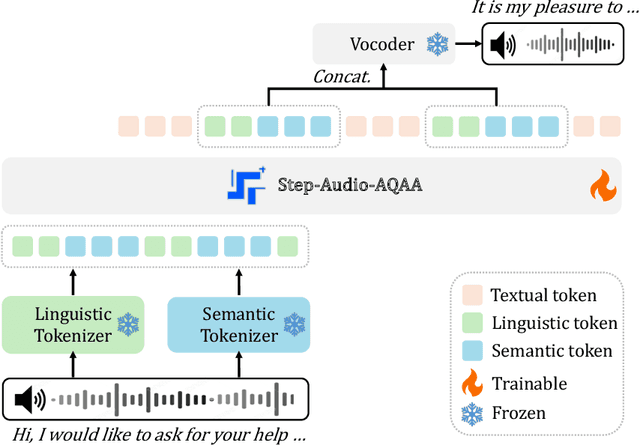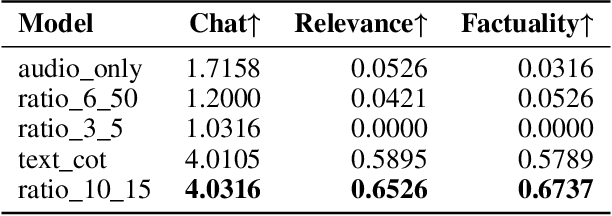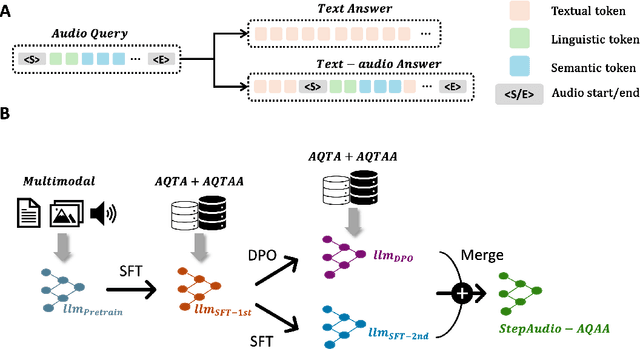Heung-Yeung Shum
Training-Free Text-Guided Color Editing with Multi-Modal Diffusion Transformer
Aug 12, 2025Abstract:Text-guided color editing in images and videos is a fundamental yet unsolved problem, requiring fine-grained manipulation of color attributes, including albedo, light source color, and ambient lighting, while preserving physical consistency in geometry, material properties, and light-matter interactions. Existing training-free methods offer broad applicability across editing tasks but struggle with precise color control and often introduce visual inconsistency in both edited and non-edited regions. In this work, we present ColorCtrl, a training-free color editing method that leverages the attention mechanisms of modern Multi-Modal Diffusion Transformers (MM-DiT). By disentangling structure and color through targeted manipulation of attention maps and value tokens, our method enables accurate and consistent color editing, along with word-level control of attribute intensity. Our method modifies only the intended regions specified by the prompt, leaving unrelated areas untouched. Extensive experiments on both SD3 and FLUX.1-dev demonstrate that ColorCtrl outperforms existing training-free approaches and achieves state-of-the-art performances in both edit quality and consistency. Furthermore, our method surpasses strong commercial models such as FLUX.1 Kontext Max and GPT-4o Image Generation in terms of consistency. When extended to video models like CogVideoX, our approach exhibits greater advantages, particularly in maintaining temporal coherence and editing stability. Finally, our method also generalizes to instruction-based editing diffusion models such as Step1X-Edit and FLUX.1 Kontext dev, further demonstrating its versatility.
Step-Audio 2 Technical Report
Jul 24, 2025Abstract:This paper presents Step-Audio 2, an end-to-end multi-modal large language model designed for industry-strength audio understanding and speech conversation. By integrating a latent audio encoder and reasoning-centric reinforcement learning (RL), Step-Audio 2 achieves promising performance in automatic speech recognition (ASR) and audio understanding. To facilitate genuine end-to-end speech conversation, Step-Audio 2 incorporates the generation of discrete audio tokens into language modeling, significantly enhancing its responsiveness to paralinguistic information such as speaking styles and emotions. To effectively leverage the rich textual and acoustic knowledge in real-world data, Step-Audio 2 integrates retrieval-augmented generation (RAG) and is able to call external tools such as web search to mitigate hallucination and audio search to switch timbres. Trained on millions of hours of speech and audio data, Step-Audio 2 delivers intelligence and expressiveness across diverse conversational scenarios. Evaluation results demonstrate that Step-Audio 2 achieves state-of-the-art performance on various audio understanding and conversational benchmarks compared to other open-source and commercial solutions. Please visit https://github.com/stepfun-ai/Step-Audio2 for more information.
Step-Audio-AQAA: a Fully End-to-End Expressive Large Audio Language Model
Jun 10, 2025



Abstract:Large Audio-Language Models (LALMs) have significantly advanced intelligent human-computer interaction, yet their reliance on text-based outputs limits their ability to generate natural speech responses directly, hindering seamless audio interactions. To address this, we introduce Step-Audio-AQAA, a fully end-to-end LALM designed for Audio Query-Audio Answer (AQAA) tasks. The model integrates a dual-codebook audio tokenizer for linguistic and semantic feature extraction, a 130-billion-parameter backbone LLM and a neural vocoder for high-fidelity speech synthesis. Our post-training approach employs interleaved token-output of text and audio to enhance semantic coherence and combines Direct Preference Optimization (DPO) with model merge to improve performance. Evaluations on the StepEval-Audio-360 benchmark demonstrate that Step-Audio-AQAA excels especially in speech control, outperforming the state-of-art LALMs in key areas. This work contributes a promising solution for end-to-end LALMs and highlights the critical role of token-based vocoder in enhancing overall performance for AQAA tasks.
Open-Reasoner-Zero: An Open Source Approach to Scaling Up Reinforcement Learning on the Base Model
Mar 31, 2025Abstract:We introduce Open-Reasoner-Zero, the first open source implementation of large-scale reasoning-oriented RL training focusing on scalability, simplicity and accessibility. Through extensive experiments, we demonstrate that a minimalist approach, vanilla PPO with GAE ($\lambda=1$, $\gamma=1$) and straightforward rule-based rewards, without any KL regularization, is sufficient to scale up both response length and benchmark performance, similar to the phenomenon observed in DeepSeek-R1-Zero. Using the same base model as DeepSeek-R1-Zero-Qwen-32B, our implementation achieves superior performance on AIME2024, MATH500, and the GPQA Diamond benchmark while demonstrating remarkable efficiency -- requiring only a tenth of the training steps, compared to DeepSeek-R1-Zero pipeline. In the spirit of open source, we release our source code, parameter settings, training data, and model weights across various sizes.
Step-Video-TI2V Technical Report: A State-of-the-Art Text-Driven Image-to-Video Generation Model
Mar 14, 2025Abstract:We present Step-Video-TI2V, a state-of-the-art text-driven image-to-video generation model with 30B parameters, capable of generating videos up to 102 frames based on both text and image inputs. We build Step-Video-TI2V-Eval as a new benchmark for the text-driven image-to-video task and compare Step-Video-TI2V with open-source and commercial TI2V engines using this dataset. Experimental results demonstrate the state-of-the-art performance of Step-Video-TI2V in the image-to-video generation task. Both Step-Video-TI2V and Step-Video-TI2V-Eval are available at https://github.com/stepfun-ai/Step-Video-TI2V.
Step-Audio: Unified Understanding and Generation in Intelligent Speech Interaction
Feb 18, 2025Abstract:Real-time speech interaction, serving as a fundamental interface for human-machine collaboration, holds immense potential. However, current open-source models face limitations such as high costs in voice data collection, weakness in dynamic control, and limited intelligence. To address these challenges, this paper introduces Step-Audio, the first production-ready open-source solution. Key contributions include: 1) a 130B-parameter unified speech-text multi-modal model that achieves unified understanding and generation, with the Step-Audio-Chat version open-sourced; 2) a generative speech data engine that establishes an affordable voice cloning framework and produces the open-sourced lightweight Step-Audio-TTS-3B model through distillation; 3) an instruction-driven fine control system enabling dynamic adjustments across dialects, emotions, singing, and RAP; 4) an enhanced cognitive architecture augmented with tool calling and role-playing abilities to manage complex tasks effectively. Based on our new StepEval-Audio-360 evaluation benchmark, Step-Audio achieves state-of-the-art performance in human evaluations, especially in terms of instruction following. On open-source benchmarks like LLaMA Question, shows 9.3% average performance improvement, demonstrating our commitment to advancing the development of open-source multi-modal language technologies. Our code and models are available at https://github.com/stepfun-ai/Step-Audio.
Taming Teacher Forcing for Masked Autoregressive Video Generation
Jan 21, 2025Abstract:We introduce MAGI, a hybrid video generation framework that combines masked modeling for intra-frame generation with causal modeling for next-frame generation. Our key innovation, Complete Teacher Forcing (CTF), conditions masked frames on complete observation frames rather than masked ones (namely Masked Teacher Forcing, MTF), enabling a smooth transition from token-level (patch-level) to frame-level autoregressive generation. CTF significantly outperforms MTF, achieving a +23% improvement in FVD scores on first-frame conditioned video prediction. To address issues like exposure bias, we employ targeted training strategies, setting a new benchmark in autoregressive video generation. Experiments show that MAGI can generate long, coherent video sequences exceeding 100 frames, even when trained on as few as 16 frames, highlighting its potential for scalable, high-quality video generation.
Multi-matrix Factorization Attention
Dec 26, 2024



Abstract:We propose novel attention architectures, Multi-matrix Factorization Attention (MFA) and MFA-Key-Reuse (MFA-KR). Existing variants for standard Multi-Head Attention (MHA), including SOTA methods like MLA, fail to maintain as strong performance under stringent Key-Value cache (KV cache) constraints. MFA enhances model capacity by efficiently scaling up both the number and dimension of attention heads through low-rank matrix factorization in the Query-Key (QK) circuit. Extending MFA, MFA-KR further reduces memory requirements by repurposing the key cache as value through value projection re-parameterization. MFA's design enables strong model capacity when working under tight KV cache budget, while MFA-KR is suitable for even harsher KV cache limits with minor performance trade-off. Notably, in our extensive and large-scale experiments, the proposed architecture outperforms MLA and performs comparably to MHA, while reducing KV cache usage by up to 56% and 93.7%, respectively.
Large Investment Model
Aug 22, 2024



Abstract:Traditional quantitative investment research is encountering diminishing returns alongside rising labor and time costs. To overcome these challenges, we introduce the Large Investment Model (LIM), a novel research paradigm designed to enhance both performance and efficiency at scale. LIM employs end-to-end learning and universal modeling to create an upstream foundation model capable of autonomously learning comprehensive signal patterns from diverse financial data spanning multiple exchanges, instruments, and frequencies. These "global patterns" are subsequently transferred to downstream strategy modeling, optimizing performance for specific tasks. We detail the system architecture design of LIM, address the technical challenges inherent in this approach, and outline potential directions for future research. The advantages of LIM are demonstrated through a series of numerical experiments on cross-instrument prediction for commodity futures trading, leveraging insights from stock markets.
Follow-Your-Pose v2: Multiple-Condition Guided Character Image Animation for Stable Pose Control
Jun 05, 2024



Abstract:Pose-controllable character video generation is in high demand with extensive applications for fields such as automatic advertising and content creation on social media platforms. While existing character image animation methods using pose sequences and reference images have shown promising performance, they tend to struggle with incoherent animation in complex scenarios, such as multiple character animation and body occlusion. Additionally, current methods request large-scale high-quality videos with stable backgrounds and temporal consistency as training datasets, otherwise, their performance will greatly deteriorate. These two issues hinder the practical utilization of character image animation tools. In this paper, we propose a practical and robust framework Follow-Your-Pose v2, which can be trained on noisy open-sourced videos readily available on the internet. Multi-condition guiders are designed to address the challenges of background stability, body occlusion in multi-character generation, and consistency of character appearance. Moreover, to fill the gap of fair evaluation of multi-character pose animation, we propose a new benchmark comprising approximately 4,000 frames. Extensive experiments demonstrate that our approach outperforms state-of-the-art methods by a margin of over 35\% across 2 datasets and on 7 metrics. Meanwhile, qualitative assessments reveal a significant improvement in the quality of generated video, particularly in scenarios involving complex backgrounds and body occlusion of multi-character, suggesting the superiority of our approach.
 Add to Chrome
Add to Chrome Add to Firefox
Add to Firefox Add to Edge
Add to Edge